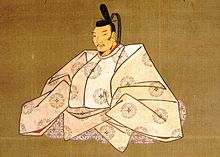- Toyotomi Hidetsugu
-
Toyotomi Hidetsugu (豊臣 秀次, 1568 – July 15, 1595) was a nephew and retainer of Toyotomi Hideyoshi who lived during the Sengoku period of the 16th century of Japan.
A practitioner of the shudō tradition, Hidetsugu had a number of Wakashū. Among these were Yamamoto Tonoma, Yamada Sanjuro, and his most beloved, Fuwano Mansaku (also Bansaku), who gained lasting renown for his beauty of body and spirit.[1]
Life
Hidetsugu was born to Hideyoshi's elder sister, but adopted by the Miyoshi clan and given the name Miyoshi Nobuyoshi. He later renamed himself Hashiba Hidetsugu, in honor of his famous uncle: "Hashiba" was the Hideyoshi's family name, and "Hidetsugu" can be translated as "next Hide".
After the Incident at Honnō-ji in 1582, Hidetsugu was given a 400 thousand koku fiefdom in Ōmi Province because he was one of Hideyoshi's few relatives. In his subsequent career as a general, Hidetsugu he sustained heavy losses in the Battle of Nagakute against Tokugawa Ieyasu, but he proved himself in Hideyoshi's Invasion of Shikoku and Siege of Odawara. He also proved a competent manager of the castle town of Ōmihachiman.
In 1590, (Tenshō 18), he was appointed castellan of Kiyosu Castle in Owari Province, where Oda Nobukatsu had once ruled. The following year, Hideyoshi lost his legitimate heir Tsurumatsu (who died before adulthood) and so gave Hidetsugu the position of Kanpaku, regent to the Emperor. This meant Hidetsugu had to move to Jurakudai in Kyoto, and resulted in a so-called "dual system of government" (二元政治) run by Hidetsugu and Hideyoshi, with the assumption that Hidetsugu would succeed Hideyoshi after his death. As Hideyoshi was busy handling the Seven-Year War in the Korean Peninsula (Battles of Bunroku and Keicho), Hidetsugu acted in his place to handle domestic affairs.
However, in 1593, Hideyoshi's mistress gave a birth to a new heir, Hideyori, and the relationship between Hidetsugu and Hideyoshi began to deteriorate. Rumours spread of Hidetsugu committing repeated and unjust murder, earning him the nickname "life-killing kanpaku" (殺生関白; sesshō-kanpaku) - although modern historians doubt that these rumours were accurate.
Finally, in 1595, Hidetsugu was accused of plotting a coup and ordered to commit seppuku at Mt. Koya. Together with him died his three wakashu, who committed seppuku with his assistance. [2]
Daimyo associated with him were confined and the Jurakudai was destroyed. Controversially, Hideyoshi ordered the execution of Hidetsugu's entire family, including children, wives and mistresses, at Sanjogawara. The harshness and brutality of executing 39 women and children shocked Japanese society and alienated many Damiyos from Toyotomi rule. Combined with the fact that Hidetsugu was the last adult member of the Toyotomi clan besides Hideyoshi himself, the whole incident is often seen to be one of the key causes of the Toyotomi downfall. In a particularly tragic case, Hideyoshi refused to spare the life of Mogami Yoshiaki's 15 year old daughter, who had only just arrived at Kyoto to become Hidestugu's concubine and had not yet even met her husband-to-be. Her death caused the powerful Mogami clan to zealously support Tokugawa Ieyasu in the Battle of Sekigahara against Toyotomi loyalist forces, a mere 5 years later.
Only one of Hidetsugu's children was spared: a daughter named Okiku, one month old, who was adopted by her grandfather's nephew, Goto Noriyoshi (Goto Okiyoshi? original: 後藤興義).
References
- ^ Ihara Saikaku, The Great Mirror of Male Love Translated, with an Introduction, by Paul Gordon Schalow, Stanford, CA: Stanford University Press, 1990, p. 166, note 1
- ^ Tsuneo Watanabe and Jun'ichi Iwata,The Love of the Samurai: A Thousand Years of Japanese Homosexuality, London: Gay Men's Press, 1989, p.54)
Categories:- 1568 births
- 1595 deaths
- Daimyo
- Seppuku
- Sessho and Kampaku
- Shudo
- Toyotomi clan
- People of Muromachi period Japan
- People of Azuchi-Momoyama period Japan
Wikimedia Foundation. 2010.

